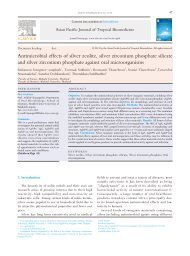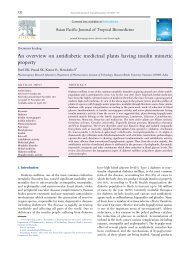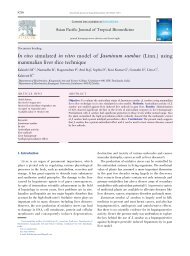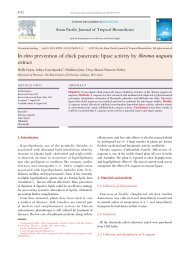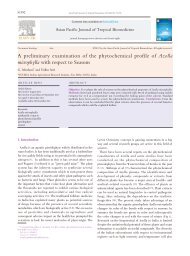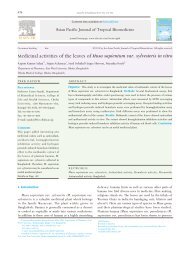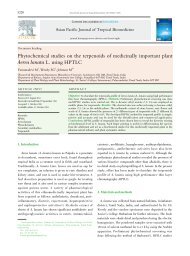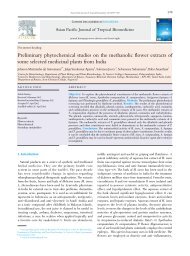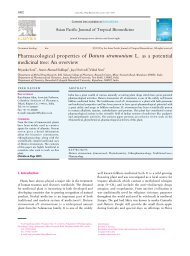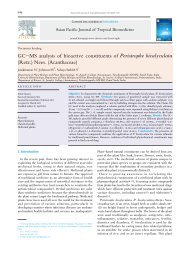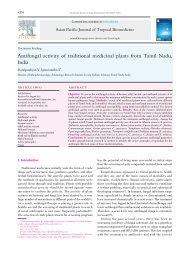Larvicidal and repellent potential of Moringa oleifera ... - Apjtb.com
Larvicidal and repellent potential of Moringa oleifera ... - Apjtb.com
Larvicidal and repellent potential of Moringa oleifera ... - Apjtb.com
Create successful ePaper yourself
Turn your PDF publications into a flip-book with our unique Google optimized e-Paper software.
124<br />
Asian Pacific Journal <strong>of</strong> Tropical Biomedicine (2011)124-129<br />
Contents lists available at ScienceDirect<br />
Asian Pacific Journal <strong>of</strong> Tropical Biomedicine<br />
journal homepage:www.elsevier.<strong>com</strong>/locate/apjtb<br />
Document heading doi:10.1016/S2221-1691(11)60009-9<br />
<strong>Larvicidal</strong> <strong>and</strong> <strong>repellent</strong> <strong>potential</strong> <strong>of</strong> <strong>Moringa</strong> <strong>oleifera</strong> against malarial<br />
vector, Anopheles stephensi Liston (Insecta: Diptera: Culicidae)<br />
Prabhu K 1*<br />
, Murugan K 2 , Nareshkumar A 2 , Ramasubramanian N 2 , Bragadeeswaran S 1<br />
1 Centre <strong>of</strong> Advanced Study in Marine Biology, Faculty <strong>of</strong> Marine, Sciences, Annamalai University, Parangipettai 608502, India<br />
2 Division <strong>of</strong> Entomology, Department <strong>of</strong> Zoology, Bharathiar University, Coimbatore-641 046, India<br />
ARTICLE INFO ABSTRACT<br />
Article history:<br />
Received 19 February 2011<br />
Received in revised form 27 February 2011<br />
Accepted 16 March 2011<br />
Available online 1 April 2011<br />
Keywords:<br />
<strong>Moringa</strong> <strong>oleifera</strong><br />
Anopheles stephensi<br />
Insecticide<br />
Larvicide<br />
Pupicide<br />
Malaria<br />
Phytochemical<br />
Mosquito vector control<br />
Plant extract<br />
<strong>Larvicidal</strong> activity<br />
1. Introduction<br />
Vector-borne diseases, such as malaria, filariasis, dengue<br />
<strong>and</strong> hemorrhagic fever (DHF), are still major public health<br />
problems in the Southeast Asian countries because <strong>of</strong> their<br />
tropical or subtropical climate. Also owing to poor drainage<br />
system, especially during rainy seasons, the presence <strong>of</strong><br />
many fish ponds, irrigation ditches <strong>and</strong> the rice fields<br />
provide abundant mosquito breeding places. Malaria <strong>and</strong><br />
other vector-borne diseases contribute to the major disease<br />
burden in India.<br />
Repeated use <strong>of</strong> synthetic insecticides for mosquito<br />
control has disrupted natural biological control systems<br />
<strong>and</strong> led to resurgences in mosquito populations. It has also<br />
*Corresponding author: Prabhu K, Doctoral Research Scholar, Centre <strong>of</strong> Advanced<br />
Study in Marine Biology, Faculty <strong>of</strong> Marine Sciences, Annamalai University,<br />
Parangipettai-608502.<br />
Tel: +91 9994933150<br />
E-mail:kul<strong>and</strong>haiprabhu@gmail.<strong>com</strong><br />
Objective: To evaluate the larvicidal <strong>and</strong> pupicidal <strong>potential</strong> <strong>of</strong> the methanolic extracts from<br />
<strong>Moringa</strong> <strong>oleifera</strong> (M. <strong>oleifera</strong>) plant seeds against malarial vector Anopheles stephensi (A. stephensi)<br />
mosquitoes at different concentrations (20, 40, 60, 80 <strong>and</strong> 100 ppm). Methods: M. <strong>oleifera</strong> was<br />
collected from the area <strong>of</strong> around Bharathiar University, Coimbatore. The dried plant materials<br />
were powdered by an electrical blender. From each sample, 100 g <strong>of</strong> the plant material were<br />
extracted with 300 mL <strong>of</strong> methanol for 8 h in a Soxhlet apparatus. The extracts were evaporated to<br />
dryness in rotary vacuum evaporator to yield 122 mg <strong>and</strong> 110 mg <strong>of</strong> dark greenish material (residue)<br />
from Arcang amara <strong>and</strong> Ocimum basilicum, respectively. One gram <strong>of</strong> the each plant residue was<br />
dissolved separately in 100 mL <strong>of</strong> acetone (stock solution) from which different concentrations,<br />
i.e., 20, 40, 60, 80 <strong>and</strong> 100 ppm were prepared. Results: <strong>Larvicidal</strong> activity <strong>of</strong> M. <strong>oleifera</strong> exhibited<br />
in the first to fourth instar larvae <strong>of</strong> the A. stephensi, <strong>and</strong> the LC 50 <strong>and</strong> LC 90 values were 57.79 ppm<br />
<strong>and</strong> 125.93 ppm for the first instar, 63.90 ppm <strong>and</strong> 133.07 ppm for the second instar, 72.45 ppm<br />
<strong>and</strong> 139.82 ppm for the third instar, 78.93 ppm <strong>and</strong> 143.20 ppm for the fourth instar, respectively.<br />
During the pupal stage the methanolic extract <strong>of</strong> M. <strong>oleifera</strong> showed that the LC 50 <strong>and</strong> LC 90 values<br />
were 67.77 ppm <strong>and</strong> 141.00 ppm, respectively. Conclusions: The present study indicates that<br />
the phytochemicals derived from M. <strong>oleifera</strong> seeds extracts are effective mosquito vector control<br />
agents <strong>and</strong> the plant extracts may be used for further integrated pest management programs.<br />
resulted in the development <strong>of</strong> resistance [1], undesirable<br />
effects on non-target organisms, <strong>and</strong> fostered environmental<br />
<strong>and</strong> human health concern that initiates a search for<br />
alternative control measures [2]. Plants are considered as<br />
a rich source <strong>of</strong> bioactive chemicals <strong>and</strong> they may be an<br />
alternative source <strong>of</strong> mosquito control agents [3].<br />
Plant products have been used by traditionally human<br />
<strong>com</strong>munities in many parts <strong>of</strong> the world against the vectors<br />
<strong>and</strong> species <strong>of</strong> insects. The phytochemicals derived from<br />
plant sources can act as larvicides, insect growth regulators,<br />
<strong>repellent</strong>s <strong>and</strong> ovipositional attractants <strong>and</strong> have deterrent<br />
activities observed by many researchers [4]. Repellents have<br />
an important place in protecting man from the bites in insect<br />
pests. An effective <strong>repellent</strong> will be useful in reducing man<br />
vector contact <strong>and</strong> in interrupting disease transmission. A<br />
<strong>repellent</strong> <strong>com</strong>pound should be toxic, non-irritating <strong>and</strong> long<br />
lasting. Amides, imides, esters <strong>and</strong> other polyfunctional<br />
<strong>com</strong>pounds are known to be good <strong>repellent</strong>s [5]. Plants could<br />
be an alternative source for mosquito <strong>repellent</strong>s because<br />
they constitute a <strong>potential</strong> source <strong>of</strong> bioactive chemicals
<strong>and</strong> typically are free from harmful effects [6]. Because <strong>of</strong> this,<br />
much interest has been focused on plant extracts, or plant<br />
essential oils as <strong>potential</strong> mosquito <strong>repellent</strong> agents [7,8] <strong>and</strong><br />
studied the interactive effect <strong>of</strong> botanicals (Neem, Pongamia)<br />
<strong>and</strong> Leucas aspera, Bacillus sphaericus against the larvae <strong>of</strong><br />
Culex quinquefasciatus.<br />
<strong>Moringa</strong> <strong>oleifera</strong> (M. <strong>oleifera</strong>) is the most widely cultivated<br />
species <strong>of</strong> a monogeneric family-the <strong>Moringa</strong>ceae, native<br />
to the sub-Himalayan tracts <strong>of</strong> India. This rapidly-growing<br />
tree (also known as the horseradish tree, drumstick tree,<br />
benzolive tree, kelor, marango, mlonge, moonga, mulangay,<br />
nebeday, saijhan, sajna or Ben oil tree), was utilized by the<br />
ancient Romans, Greeks <strong>and</strong> Egyptians, <strong>and</strong> it is now widely<br />
cultivated <strong>and</strong> has be<strong>com</strong>e naturalized in many locations in<br />
the tropics. All parts <strong>of</strong> the <strong>Moringa</strong> tree are edible <strong>and</strong> have<br />
long been consumed by humans. In the West, one <strong>of</strong> the<br />
best known uses <strong>of</strong> <strong>Moringa</strong> is to flocculate contaminants<br />
<strong>and</strong> purify drinking water with its powdered seeds [9-11]. This<br />
tree has in recent times been advocated as an outst<strong>and</strong>ing<br />
indigenous source <strong>of</strong> highly digestible protein, Ca, Fe,<br />
Vitamin C, <strong>and</strong> carotenoids suitable for utilization in many<br />
<strong>of</strong> the so-called “developing” regions <strong>of</strong> the world where<br />
undernourishment is a major concern. In the present study<br />
an attempt was made to evaluate the toxicity <strong>of</strong> M. <strong>oleifera</strong><br />
on malarial vector, Anopheles stephensi (An. stephensi).<br />
2. Materials <strong>and</strong> methods<br />
2.1. Plant collection <strong>and</strong> preparation <strong>of</strong> plant extract<br />
The plant M. <strong>oleifera</strong> was collected from the area around<br />
Bharathiar University, Coimbatore. The dried plant materials<br />
were powdered by an electrical blender. From each sample,<br />
100 g <strong>of</strong> the plant materials were extracted with 300 mL <strong>of</strong><br />
methanol for 8 h in a Soxhlet apparatus. The plant extracts<br />
were evaporated to dryness in rotary vacuum evaporator to<br />
yield 122 mg <strong>and</strong> 110 mg <strong>of</strong> dark greenish material (residue)<br />
from Arcang amara <strong>and</strong> Ociumum basilicum, respectively.<br />
One gram <strong>of</strong> each plant residue was dissolved separately<br />
in 100 mL <strong>of</strong> acetone (stock solution) from which different<br />
concentrations, i.e., 20, 40, 60, 80 <strong>and</strong> 100 ppm were prepared.<br />
2.2. Test for larvicidal activity [12]<br />
An. stephensi was used to test the the larvicidal <strong>and</strong><br />
pupicidal activity <strong>of</strong> M. <strong>oleifera</strong>. It was maintained at (27暲<br />
2) 曟, (75%-85%) RH, under 14 L: 10D photoperiod cycles.<br />
The larvae were fed with dog biscuits <strong>and</strong> yeast at 3:1 ratio.<br />
Twenty-five I, II, III <strong>and</strong> IV instar larvae <strong>and</strong> pupae <strong>of</strong><br />
An. stephensi were kept in 500 mL glass beaker containing<br />
249 mL <strong>of</strong> dechlorinated water <strong>and</strong> 1.0 mL <strong>of</strong> desired<br />
plant extract concentration. Three replicates for each<br />
concentration were set up. A control was set up with 1.0 mL<br />
<strong>of</strong> acetone in 249 mL <strong>of</strong> dechlorinated water. The control<br />
K. Prabhu et al./Asian Pacific Journal <strong>of</strong> Tropical Biomedicine (2011)124-129 125<br />
mortality was corrected by Abbott's formula [13] <strong>and</strong> LC 50,<br />
LC 90, regression equation, <strong>and</strong> 95% confidence limit <strong>of</strong> lower<br />
confidence limit (LCL) <strong>and</strong> upper confidence limit (UCL)<br />
were calculated by using probit analysis [14].<br />
2.3. Pupicidal activity<br />
A laboratory colony <strong>of</strong> mosquito pupae was used for<br />
pupicidal activity. Ten freshly emerged pupae were<br />
introduced into each testing cup (sterilized plastic<br />
drinking cup <strong>of</strong> 150 mL capacity), which contained 100 mL<br />
<strong>of</strong> dechlorinated tap water. A measured volume <strong>of</strong> stock<br />
solution was added to obtain the desired concentrations.<br />
Experiments were carried out with a series <strong>of</strong> fiveseven<br />
concentrations, 20%, 40%, 60%, 80%, <strong>and</strong> 100%,<br />
respectively, each with 5 replicates <strong>and</strong> a final total number<br />
<strong>of</strong> 100 pupae for each concentration. The LC 50 <strong>and</strong> LC 90 were<br />
determined by a probit analysis program [14]. Control mortality<br />
was accounted by the formula <strong>of</strong> Abbott's [13].<br />
2.4. Repellent activity<br />
Repellent activity <strong>of</strong> plant <strong>com</strong>pounds was tested with<br />
human volunteers. For the <strong>repellent</strong> activity <strong>of</strong> plant extracts<br />
percentage protection in relation to dose method was<br />
adopted [7,12]. Three to four days old blood starved female<br />
adult mosquitoes (100) were kept in a net cage. The arms <strong>of</strong><br />
the tested person were cleaned with isopropanol. After airdrying<br />
the arm only 25 cm 2<br />
<strong>of</strong> the dorsal side <strong>of</strong> the skin on<br />
each arm was exposed, the remaining area being covered by<br />
rubber gloves.<br />
The plant extract was dissolved in isopropanol <strong>and</strong> the<br />
alcohol served as control. The plant extract at 0.5, 1.0 <strong>and</strong> 2.0<br />
mg/cm 2<br />
concentrations was applied. The control <strong>and</strong> treated<br />
arms were introduced simultaneously into the cage. The<br />
number <strong>of</strong> bites was counted over 5 min every 60 min, from<br />
20:00 to 6:00. The experiment was conducted five times. The<br />
percentage protection was calculated by using the following<br />
formula.<br />
Number <strong>of</strong> bites received by control arm -<br />
Number <strong>of</strong> bites received by treated arm<br />
% Protection = 暳 100<br />
Number <strong>of</strong> bites received by control arm<br />
T = the number <strong>of</strong> mosquitoes collected from treated areas.<br />
2.5. Smoke toxicity test<br />
M. olifera seed extract was used for smoke toxicity assay.<br />
The mosquito coils were prepared following the method <strong>of</strong><br />
Saini et al [15] with minor modification by using 4 g <strong>of</strong> coconut<br />
shell, charcoal powder as burning material. All the three was<br />
thoroughly mixed with distilled water to form a semisolid<br />
paste. Mosquito coils (0.6 cm thickness) were prepared<br />
manually <strong>and</strong> shade dried. The control coils were prepared<br />
without the plant ingredient.
126<br />
The experiments were conducted in a glass chamber <strong>of</strong><br />
140 cm 暳 120 cm 暳 60 cm. A window <strong>of</strong> 60 cm 暳 30 cm was<br />
situated at mid bottom <strong>of</strong> one side <strong>of</strong> the chamber. Hundred<br />
<strong>of</strong> three or four days' old blood starved adult female<br />
mosquitoes, fed with sucrose solution, were released into<br />
the chamber. A belly shaven pigeon was kept tied inside the<br />
cage in immobilized condition. The experimental chamber<br />
was tightly closed. The experiment was repeated five times<br />
on separate days, including control mosquitoes <strong>of</strong> the<br />
same age groups. The data were pooled <strong>and</strong> average values<br />
were subsequently used for calculations. Controls were<br />
maintained in two sets. One set was run with coil lacking the<br />
active ingredient <strong>of</strong> plant powder (control I), the other was a<br />
<strong>com</strong>mercial coil (Mortein coil) which was used for positive<br />
control to <strong>com</strong>pare the effectiveness <strong>of</strong> plant coils. After the<br />
experiment over fed <strong>and</strong> unfed (active <strong>and</strong> dead) mosquitoes<br />
were counted.<br />
The protection given by the smoke from plant samples<br />
against the biting <strong>of</strong> adult mosquito was calculated in terms<br />
<strong>of</strong> percentage <strong>of</strong> unfed mosquitoes due to treatment.<br />
No. <strong>of</strong> unfed mosquitoes in treatment -<br />
No. <strong>of</strong> unfed mosquito in control I<br />
% Protection= 暳 100<br />
No. <strong>of</strong> mosquitoes treated<br />
2.6. Field trial<br />
For the field trial study, mosquito breeding sites were at<br />
the endemic districts <strong>of</strong> Tamil Nadu. The field trials were<br />
conducted by using required concentration <strong>of</strong> plant extracts<br />
<strong>and</strong> bacterial pesticide in different breeding habitat, such as<br />
overhead tank, cement tank <strong>and</strong> cement container. Selection<br />
<strong>of</strong> the localities was decided on the basis <strong>of</strong> the breeding<br />
<strong>potential</strong> <strong>and</strong> operational convenience. Field application <strong>of</strong><br />
the plant extracts <strong>and</strong> bacterial pesticides was done with the<br />
help <strong>of</strong> a knapsack sprayer (or) h<strong>and</strong> sprayer. Biopesticide<br />
was sprayed uniformly on the surface <strong>of</strong> the water in each<br />
habitat. The mean larval density was calculated on the<br />
basis <strong>of</strong> 5 dips per each habitat. Prior to the experiment the<br />
surface area <strong>of</strong> the breeding habitat was measured along<br />
with the pre-spray density <strong>of</strong> larvae. 24 h after the treatment<br />
the post-spray density <strong>of</strong> larvae was recorded. Successive<br />
observations were made at an interval <strong>of</strong> one day. The<br />
percentage reduction was calculated by the following<br />
formula [7].<br />
% reduction=100 - (C 1 / T 1 暳 T 2 / C 2)<br />
Where, C 1 <strong>and</strong> T 1 are pre-treatment density <strong>and</strong> T 2 <strong>and</strong><br />
C 2 are the post-treatment density <strong>of</strong> larvae per dip in the<br />
control <strong>and</strong> treated habitats, respectively.<br />
2.7. Statistical analysis<br />
The mortality observed (ppm) was corrected using Abbott's<br />
K. Prabhu et al./Asian Pacific Journal <strong>of</strong> Tropical Biomedicine (2011)124-129<br />
formula during the observation <strong>of</strong> the larvicidal <strong>potential</strong>ity<br />
<strong>of</strong> the plant extracts. Statistical analysis <strong>of</strong> the experimental<br />
data was performed using the <strong>com</strong>puter s<strong>of</strong>tware SPSS 14<br />
version <strong>and</strong> MS EXCEL 2003 to find the LC 50, regression<br />
equations (Y = mortality; X = concentrations) <strong>and</strong> regression<br />
coefficient values.<br />
3. Results<br />
The results <strong>of</strong> larvicidal <strong>and</strong> pupicidal activity <strong>of</strong> M.<br />
<strong>oleifera</strong> were presented in Figure 1. The plant extract<br />
exhibited larvicidal activities on different instars (I, II, III <strong>and</strong><br />
IV) <strong>and</strong> pupa <strong>of</strong> An. stephensi. The LC 50 <strong>and</strong> LC 90 values <strong>of</strong> M.<br />
<strong>oleifera</strong> for I instar larvae were 57.79 ppm <strong>and</strong> 125.93 ppm,<br />
II instar 63.90 ppm <strong>and</strong> 133.07 ppm, III instar 72.45 ppm <strong>and</strong><br />
139.82 ppm, IV instar 78.93 ppm <strong>and</strong> 143.20 ppm, respectively.<br />
The LC 50 <strong>and</strong> LC 90 values <strong>of</strong> M. <strong>oleifera</strong> for pupa were 67.77<br />
ppm <strong>and</strong> 141.00 ppm. The regression equation values <strong>of</strong> M.<br />
<strong>oleifera</strong> for I instar larvae were Y= -1.087 01 + 0.018 81X,<br />
II instar Y= 0-1.184 07 + 0.018 53X, III instar Y= -1.378 29 +<br />
0.019 02X <strong>and</strong> IV instar Y= -1.574 0 + 0.019 94X, respectively.<br />
The regression equation values <strong>of</strong> pupae were Y= -1.186 04<br />
+ 0.017 50X. The LC 50 <strong>and</strong> LC 90 values <strong>of</strong> pupae were 6.792%,<br />
5.449% <strong>and</strong> 16.925%, 15.474%. Among the different larval<br />
stages, the I instar larvae were more susceptible than the<br />
other instar larvae. The plant extract showed considerable<br />
larval <strong>and</strong> pupal mortality. The Chi-square values were<br />
significant at P0.05%).<br />
Table 2 showed the <strong>repellent</strong> activity <strong>of</strong> M. <strong>oleifera</strong> against<br />
An. stenphensi <strong>and</strong> it was does dependent. Repellency<br />
was increased after the does increased. For example<br />
90.41% repellency was noted at 100% concentration <strong>and</strong><br />
23.28% repellency was reduced after the treatment <strong>of</strong> 20%<br />
concentration. The <strong>repellent</strong> activity was carried out in<br />
the evening from 5.00 -10.00 pm. The repellency was low<br />
at 20% concentration whereas it has been increased at<br />
100% concentration. An average production was at 60%<br />
concentration which could make 58.90% production against<br />
An. stephensi.
K. Prabhu et al./Asian Pacific Journal <strong>of</strong> Tropical Biomedicine (2011)124-129 127<br />
Table 1<br />
LC 50 <strong>and</strong> LC 90 <strong>of</strong> larval <strong>and</strong> pupal toxicity effect <strong>of</strong> M. <strong>oleifera</strong> on malarial vector, An. stephensi Liston.<br />
Larval <strong>and</strong> pupal stage LC50 <strong>and</strong> LC90 (ppm) Regression equation<br />
95% Confidence limit<br />
Chi-square value (氈 2<br />
LCL LC50 (LC90) UCL LC50 (LC90) )<br />
I 57.79 (125.93) Y=-1.087 01 + 0.018 81X 51.38 (112.49) 64.02 (146.47) 1.51*<br />
II 63.90 (133.07) Y=-1.184 07 + 0.018 53X 57.64 (118.45) 70.54 (155.67) 1.60*<br />
III 72.45 (139.82) Y=-1.378 29 + 0.019 02X 66.28 (124.51) 79.72 (163.45) 0.24*<br />
IV 78.93 (143.20) Y= -1.574 0 + 0.019 94X 72.67 (127.88) 86.72 (166.64) 2.27*<br />
Pupa 67.77 (141.00) Y= -1.186 04 + 0.017 50X 61.19 (124.42) 75.14 (167.43) 3.06*<br />
*Significance at P < 0.05 level.<br />
Table 2<br />
Repellent activity <strong>of</strong> M. <strong>oleifera</strong> (methanol extract) on malarial vector An. stephensi Liston.<br />
Repellent activity observation<br />
Control<br />
5.00-6.00 24.0暲1.2 a<br />
6.00-7.00 19.8暲1.2 b<br />
7.00-8.00 13.1暲0.9 c<br />
8.00-9.00 10.0暲0.9 bc<br />
9.00-10.00 7.0暲1.2 d<br />
Number <strong>of</strong> mosquito fed<br />
Concentration <strong>of</strong> extract (%)<br />
20 40 60 80 100<br />
17.1暲2.0 a<br />
16.0暲1.2 b<br />
10.0暲0 c<br />
8.3暲0.9 bc<br />
5.0暲1.2 d<br />
15.0暲1.2 a<br />
13.4暲1.2 b<br />
6.0暲0.9 c<br />
4.1暲2.0 d<br />
3.3暲0.8 e<br />
10.3暲0.9 a<br />
9.4暲1.2 ab<br />
5.0暲1.2 b<br />
3.0暲2.0 c<br />
3.3暲0.9 c<br />
6.0暲0.9 a<br />
5.0暲2.0 ab<br />
3.0暲1.2 c<br />
2.2暲1.2 d<br />
1.3暲0.5 e<br />
Fed mosquitoes 73 56 41 30 17 7<br />
Unfed mosquitoes 27 44 59 70 83 93<br />
2.0暲0.9 a<br />
2.1暲0.5 b<br />
1.3暲0 c<br />
1.1暲0.5 bc<br />
1.0暲0.8 d<br />
Percentage <strong>of</strong> protection 23.28 43.83 58.90 76.71 90.41<br />
Table 3<br />
Smoke toxicity effect <strong>of</strong> M. <strong>oleifera</strong> leaf, seed <strong>and</strong> oil on An. stephensi.<br />
M. <strong>oleifera</strong> No. <strong>of</strong> mosquitoes tested Fed mosquitoes Unfed mosquitoes Total % Unfed over control I<br />
Leaf 100 24 ab 31 b<br />
Seed 100 25 b<br />
Control I 100 82 a<br />
Control II 100 14 c<br />
Within column means followed by the same letter(s) are not significantly different at 5% level by DMRT; Control 1 = Negative control -<br />
blank without plant material; Control 2 = Positive control - Mortein coil.<br />
Table 4<br />
Field evaluation <strong>of</strong> the M. <strong>oleifera</strong> (methanolic extract) seed extract on malarial vector, An. stephensi.<br />
No<br />
Before treatment<br />
24 h<br />
Larval density<br />
After treatment<br />
48 h 72 h<br />
1 80.0暲4.0 a<br />
31.0暲0.8 a<br />
20.0暲1.6 a<br />
9.3暲0.9 a<br />
2 68.0暲1.6 b<br />
26.3暲1.2 b<br />
13.0暲0.8 b<br />
5.6暲0.4 b<br />
3 57.6暲2.0 ab<br />
17.3暲0.9 ab<br />
10.3暲0.4 c<br />
4.3暲0.4 bc<br />
4 44.0暲2.1 c<br />
12.0暲2.1 c<br />
5.3暲0.4 bc<br />
5.3暲0.9 c<br />
5 32.3暲2.0 bc<br />
8.3暲1.2 bc<br />
3.0暲0.8 d<br />
1.6暲0.4 d<br />
6 26.6暲2.4 d<br />
3.6暲1.2 d<br />
2.3暲0.8 e<br />
0.3暲0.4 e<br />
Total 285 86 60 29<br />
Average 47.5 14.3 10 4.8<br />
Reduction - 69.8% 78.9% 89.8%<br />
Within column means followed by the same letter(s) are significancely at 0.05% level by DMRT.<br />
40 a<br />
18 c<br />
26 ab<br />
45 b<br />
35 ab<br />
0 c<br />
60 a<br />
76 b<br />
75 ab<br />
18 c<br />
86 a<br />
58 ab<br />
64 b<br />
-<br />
68 a
128<br />
Table 3 provided the results <strong>of</strong> smoke toxicity effect <strong>of</strong><br />
M. <strong>oleifera</strong> on biting activity <strong>of</strong> An. stephensi. Two grams<br />
<strong>of</strong> plant ingredients from M. <strong>oleifera</strong> plant were used for<br />
smoke toxicity. The control was maintained without plant<br />
ingredients. It acts as negative control. The <strong>com</strong>mercially<br />
available (Mortein) mosquito coil was used as positive<br />
control.<br />
One hundred <strong>of</strong> 4 -3 days starved An. stephensi mosquitoes<br />
were used. After the treatment <strong>of</strong> the plant, the fed <strong>and</strong><br />
unfed mosquitoes were counted. There were 24 fed <strong>and</strong> 76<br />
unfed mosquitoes after the treatment <strong>of</strong> M. <strong>oleifera</strong> leaf.<br />
In the treatment <strong>of</strong> M. <strong>oleifera</strong> seed, fed 25 <strong>and</strong> unfed 75<br />
were counted. Among the two parts tested against biting <strong>of</strong><br />
adult, there was more increased mortality after the smoke<br />
emerged from the coil made up <strong>of</strong> seed than other parts. The<br />
production given by the smoke from the M. <strong>oleifera</strong> leaves<br />
<strong>and</strong> seeds was respectively 58% <strong>and</strong> 64%. Comparisons with<br />
other plant showed that its efficacy was very high, but the<br />
<strong>com</strong>bined effect <strong>of</strong> each plant showed good smoke toxicitic<br />
effect on An. stephensi.<br />
Table 4 showd the field trial after using M. <strong>oleifera</strong> seed<br />
extracts against malarial vector, An. stephensi. The field<br />
study was conducted in mosquito breeding site, such as<br />
overhead water tank <strong>and</strong> water storage places. Field trial<br />
was conducted by using the M. <strong>oleifera</strong> seed extract against<br />
malarial vector, An. stephensi (overhead tank) sprayed by<br />
using knapsack sprayer. Bioefficacy <strong>of</strong> plant extract was<br />
noted based on the lethal concentration <strong>of</strong> plants. The LC 90<br />
value was double for M. <strong>oleifera</strong> sprayed individually at<br />
different breeding sites <strong>of</strong> malarial vector. The percentage<br />
<strong>of</strong> larval reduction was noticed in 24 h, 48 h <strong>and</strong> 72 h at the<br />
breeding sites. After treatment with M. <strong>oleifera</strong> extract, the<br />
larval reduction was 73.9%, 84.8% <strong>and</strong> 94.2% at 24 h, 48 h<br />
<strong>and</strong> 72 h, respectively on malarial vector An. stephhensi.<br />
4. Discussion<br />
Many researches have been conducted on plant derived<br />
chemicals which are non-toxic to man <strong>and</strong> domestic<br />
animals <strong>and</strong> serve as useful basis for the development<br />
<strong>of</strong> safer <strong>and</strong> more selective mosquito insecticides [16]. As<br />
<strong>com</strong>pared with other herbal extracts, M. <strong>oleifera</strong> seed extract<br />
also acts as larvicidal <strong>and</strong> pupicidal agent <strong>and</strong> studies<br />
have been reported on water-extracted M. <strong>oleifera</strong> seeds<br />
(WEMOS) against Aedes aegypti larvae, <strong>and</strong> methanolextracted<br />
M. <strong>oleifera</strong> roots against Culex quinquefasciatus<br />
<strong>and</strong> Aedes Albopictus. Results obtained after the treatment<br />
<strong>of</strong> M. <strong>oleifera</strong> against An. stephensi were encouraging. The<br />
obtained larval <strong>and</strong> pupal mortality may be due to the active<br />
chemical <strong>com</strong>pounds present in M. <strong>oleifera</strong>. Quercetin <strong>and</strong><br />
kaempferol are flavonoids, <strong>com</strong>pounds <strong>of</strong> phenolic hydroxyl<br />
groups <strong>of</strong> M. <strong>oleifera</strong> with antioxidant action <strong>of</strong> <strong>potential</strong><br />
therapeutic uses [17].<br />
Since An. stephensi breeds in drinking water tank many<br />
<strong>of</strong> plant extracts are subject to risk factors in mosquito<br />
K. Prabhu et al./Asian Pacific Journal <strong>of</strong> Tropical Biomedicine (2011)124-129<br />
control. The plant extracts which are highly toxic against<br />
the An. stephensi are also toxic to human beings. In the<br />
present study M. <strong>oleifera</strong> seed extract shows good effect<br />
on An. stephensi <strong>and</strong> it is also non-toxic to human beings.<br />
Many previous studies proved that the extract <strong>of</strong> M. <strong>oleifera</strong><br />
is a water purifying agent. M. <strong>oleifera</strong> seeds can be used<br />
as a natural coagulant (primary coagulant) in household<br />
water treatment as well as in the <strong>com</strong>munity water treatment<br />
systems [18]. Hence, it can be considered that the seed extract<br />
<strong>of</strong> M. <strong>oleifera</strong> is not only a mosquitocidal agent, but also a<br />
water treatment agent. The present study also revealed that<br />
the seed extracts <strong>of</strong> M. <strong>oleifera</strong> have a promising larvicidal<br />
efficacy. Plants are rich sources <strong>of</strong> bioactive organic<br />
chemicals <strong>and</strong> <strong>of</strong>fer an advantage over synthetic pesticides<br />
as the plants are less toxic, less prone to development <strong>of</strong><br />
resistance, <strong>and</strong> easily biodegradable. The seed extract <strong>of</strong><br />
M. <strong>oleifera</strong> will play an important role in the control <strong>of</strong><br />
mosquitoes.<br />
Repellents are used as personal protection methods against<br />
biting arthropods with the major aim <strong>of</strong> avoiding nuisance [19].<br />
Insect <strong>repellent</strong>s are considered useful alternatives where<br />
other control measures are neither practical nor possible.<br />
Repellents properly utilized are an inexpensive means <strong>of</strong><br />
reducing or preventing a wide range <strong>of</strong> vector [20].<br />
Many plant extracts <strong>and</strong> essential oils manifest <strong>repellent</strong><br />
activity against different mosquito species [16]. The biological<br />
activity <strong>of</strong> the plant extracts might be due to a variety <strong>of</strong><br />
<strong>com</strong>pounds in Solanum tribolium plant, including phenolics,<br />
terpinoids <strong>and</strong> alkaloids. These <strong>com</strong>pounds may jointly or<br />
independently contribute to causing oviposition deterrent<br />
<strong>and</strong> skin <strong>repellent</strong> activity against An. stephensi [21].<br />
The present findings have important implications in<br />
the practical control <strong>of</strong> mosquito larvae in the polluted<br />
aquatic ecosystem. The plants studied are available in large<br />
quantities. These extracts are easy to h<strong>and</strong>le, inexpensive<br />
<strong>and</strong> safe natural products for mosquito control [5]. The<br />
extracts <strong>of</strong> murungai (Local Tamil Name) seed can also be<br />
used for water purification [22]. In view <strong>of</strong> residue problems in<br />
the environment <strong>and</strong> the development <strong>of</strong> insect resistance<br />
to synthetic insecticides like DDT <strong>and</strong> other chlorinated<br />
hydrocarbons, the recent trend is to explore plants to obtain<br />
extracts that are safe for non target animals <strong>and</strong> do not<br />
pose any residue problem but are still able to suppress pest<br />
populations. Though several <strong>com</strong>pounds <strong>of</strong> plant origin have<br />
been reported as larvicides [23-32], there is a wide scope for<br />
the discovery <strong>of</strong> more effective plant products [15]. Further<br />
research undoubtedly will lead to improved formulations<br />
with enhanced activity which may eventually be<strong>com</strong>e<br />
environmentally acceptable <strong>and</strong> replace objectionable<br />
conventional insecticides for mosquito control. It may be<br />
concluded that the nature possesses numerous medicinal<br />
plants, which may be useful for control <strong>of</strong> vector borne<br />
diseases.<br />
Conflict <strong>of</strong> interest statement
We declare that we have no conflict <strong>of</strong> interest.<br />
Acknowledgements<br />
Authors are thankful to Pr<strong>of</strong>. G. Vanithakumari, Head<br />
<strong>of</strong> the Department, Department <strong>of</strong> Zoology, Bharathiar<br />
University for giving facilities <strong>and</strong> encouragement during<br />
the study period.<br />
References<br />
[1] Brown AWA. Insecticide resistance in mosquitoes: pragmatic<br />
review. J Am Mosq Control Assoc 1986; 2: 123-140.<br />
[2] Hayes JB, Laws ER. H<strong>and</strong>book <strong>of</strong> pesticide toxicology. San Diego:<br />
Academic Press; 1991.<br />
[3] Georgewill OA, Georgewill UO, Nwankwoala RNP. Antiinflammatory<br />
effects <strong>of</strong> Morninga <strong>oleifera</strong> lam extract in rats.<br />
Asian Pac J Trop Med 2010; 3(2): 133-135.<br />
[4] Babu R, Murugan K. Interactive effect <strong>of</strong> neem seed kernel <strong>and</strong><br />
neem gum extracts on the control <strong>of</strong> Culex quinquefasciatus say.<br />
Neem Newslett 1998; 15(2): 9-11.<br />
[5] Kalyanasundaram M Das. <strong>Larvicidal</strong> synergistic activity <strong>of</strong> plant<br />
extracts for mosquito control. Indian J Med Res 1982; 82: 19-23.<br />
[6] Isman MB. Leads <strong>and</strong> prospects for the development <strong>of</strong> new<br />
botanical insecticides. Rev Pestic Toxicol 1995; 3: 1-20.<br />
[7] Murugan K, Vahitha R, Baruah I, Das SC. Integration <strong>of</strong><br />
botanicals <strong>and</strong> microbial pesticides for the control <strong>of</strong> Wlarial<br />
vector, Culex quinquefasciatus. Ann Med Entomol 2003; 12<br />
(1&2): 11-23.<br />
[8] Yang YC, Le EH, Lee HS, Lee DK, Ahn YJ. Repellency <strong>of</strong><br />
aromatic medicinal plant extracts <strong>and</strong> a steam distillate to Aedes<br />
aegypti. J Am Mosq Control Assoc 2004; 20(2): 146-149.<br />
[9] Berger MR, Habs M, Jahn SA, SchmahlS. Toxicological<br />
assessment <strong>of</strong> seeds from <strong>Moringa</strong> <strong>oleifera</strong> <strong>and</strong> <strong>Moringa</strong><br />
stenopetala two highly efficient primary coagulants for domestic<br />
water treatment <strong>of</strong> tropical raw waters. E Afr Med J 1984; 61:<br />
712-716.<br />
[10] Gassenschmidt U, Jany KD, Tauscher B, Niebergall H. Isolation<br />
<strong>and</strong> characterization <strong>of</strong> a flocculating protein from <strong>Moringa</strong><br />
<strong>oleifera</strong> Lam. Biochim Biophys Acta 1995; 1243: 477-481.<br />
[11] Olsen A. Low technology water purification by bentonite clay<br />
<strong>and</strong> <strong>Moringa</strong> <strong>oleifera</strong> seed flocculation as performed in Sudanese<br />
villages. Effects on Schistosoma mansoni cercariae. Water Res<br />
1987; 21(5): 517-522.<br />
[12] WHO. Report <strong>of</strong> the WHO informal consultation on the evaluation<br />
<strong>and</strong> testing <strong>of</strong> insecticides CTD/WHO PES/IC/96.1. Geneva:<br />
WHO; 1996, p. 69.<br />
[13] Abbott WS. A method <strong>of</strong> <strong>com</strong>puting the effectiveness <strong>of</strong> an<br />
insecticide. 1925. J Am Mosq Control Assoc 1987; 3: 302-303.<br />
[14] Finney DJ. Probit analysis. 3rd ed. London: Cambridge<br />
University Press; 1971.<br />
[15] Saxena SC, Yadav RS. A preliminary laboratory evaluation <strong>of</strong><br />
an extract <strong>of</strong> leaves <strong>of</strong> Delonix regia Raf. as a disruptor <strong>of</strong> insect<br />
growth <strong>and</strong> development. Trop Pestic Manag 1986; 32: 58-59.<br />
[16] Marimuthu G. Larvicida <strong>and</strong> <strong>repellent</strong> activities <strong>of</strong> Sida acuta<br />
Bum.F. (Family: Malvaceae) against three important vector<br />
K. Prabhu et al./Asian Pacific Journal <strong>of</strong> Tropical Biomedicine (2011)124-129 129<br />
mosquitoes. Asian Pac J Trop Med 2010; 3(9): 691-695.<br />
[17] Pace-Asciak CR, Hahn S, Diam<strong>and</strong>is EP, Soleas G, Goldberg<br />
DM. The red wine phenolics transresveratrol <strong>and</strong> quercetin block<br />
human platelet aggregation in eicosanoid synthesis: implication<br />
for protection against coronary heart disease. Clin Chim Acta<br />
1995; 235(2): 207-219.<br />
[18] Schwarz D. Water clarification using <strong>Moringa</strong> <strong>oleifera</strong>. Eschborn:<br />
JDWH Information Service; 2000. [Online] Available from:<br />
http://www.gtz.de/gate/gateid.afp<br />
[19] Trigg JK. Evaluation <strong>of</strong> a eucalyptus based <strong>repellent</strong> against<br />
Anopheles spp. in Tanzania. Am Mosq Control Assoc 1996; 12:<br />
243-246.<br />
[20] Gupta RK, Ruteledge LC. Laboratory evaluation <strong>of</strong> controlledrelease<br />
<strong>repellent</strong> formulations on human volunteers under three<br />
climatic regimens. J Am Mosq Control Assoc 1989; 5: 52-5.<br />
[21] Jed WF. <strong>Moringa</strong> <strong>oleifera</strong>: a review <strong>of</strong> the medical evidence for<br />
its nutritional, therapeutic, <strong>and</strong> prophylactic properties. Trees<br />
Life J 2005; 1: 5.<br />
[22] Patterson BD, Khalil SKW, Schermeister LJ, Quraishi MS.<br />
Plant-insecticide interactions. Biol Phytochem Eval Selected<br />
Plants 1975; 38: 391-403.<br />
[23] Jeyabalan D, Murugan K. Impact <strong>of</strong> variation in foliar<br />
constituents <strong>of</strong> Mangifera indica on consumption <strong>and</strong> digestion<br />
efficiency <strong>of</strong> Latoia lepida. Indian J Exp Biol 1996; 34:<br />
472-474.<br />
[24] Curtis CF, Lines JD, Lu B, Renz A. Natural <strong>and</strong> synthetic<br />
<strong>repellent</strong>s. In: Curtis CF. (ed.) Appropriate technology in vector<br />
control. Florida: CRC Press; 1989, p. 76-89.<br />
[25] Curtis CF, Lines JD, Lu B, Renz A. Natural <strong>and</strong> synthetic<br />
<strong>repellent</strong>s. In: CF Curtis. (ed.) Appropriate technology in vector<br />
control. Boca Raton Florida: USA CRC Press; 1990, p. 75-199.<br />
[26] Foidl N, Makkar HPS, Becker K. The <strong>potential</strong> <strong>of</strong> <strong>Moringa</strong><br />
<strong>oleifera</strong> for agricultural <strong>and</strong> industrial uses. Proceedings <strong>of</strong> the<br />
1th workshop what development <strong>potential</strong> for <strong>Moringa</strong> products?<br />
Dares Salaam: International Workshop; 2001.<br />
[27] Murugan K, Jahanmohani P, Babu R. Effect <strong>of</strong> neen kernal<br />
extract <strong>and</strong> neem oil on nutritive <strong>and</strong> reporactive physioliogy <strong>of</strong><br />
Helianthus armigera Hub. Neem <strong>and</strong> Environment. Delhi: Oxford<br />
<strong>and</strong> IBH Co., Pvt.Ltd.; 1996, p. 321-334.<br />
[28] Pushpalatha E, Muthukrishnan J. <strong>Larvicidal</strong> activity <strong>of</strong> few plant<br />
extracts against Culex quinquefasciatus <strong>and</strong> Anopheles stephensi.<br />
Indian J Malariol 1995; 32: 14-23.<br />
[29] Rajkumar S, Jebanesan A. Ovicidal activity <strong>of</strong> Solanum<br />
trilobatum Linn (Solanaceae) leaf extract against Culex<br />
quinquefasciatus Say <strong>and</strong> Culex tritaeniorhynchus Gile (Diptera:<br />
Culicidae). Int J Trop Insect Sci 2004; 24(4): 340-342.<br />
[30] Saxena RC, HarshanV, Saxena A, Sukumaran P, Sharma MC,<br />
Lakshanakumar M. <strong>Larvicidal</strong> <strong>and</strong> chemosterilant activity <strong>of</strong><br />
Annona squamosa alkaloids against Anopheles stephensi. J Am<br />
Mosq Control Assoc 1993; 9(1): 84-87.<br />
[31] Sharma M, Saxena RC. Phytoxicological activity <strong>of</strong> Tagetes<br />
erectes in aquatic stages <strong>of</strong> Anopheles stephensi. Indian J Malariol<br />
1994; 31: 21-26.<br />
[32] Vat<strong>and</strong>oost H, Mamiv<strong>and</strong>poor H, Shayeghi M, Abai MR,<br />
Yaghoobi EMR, Raeisi A, et al. Evaluation <strong>of</strong> bioefficacy <strong>of</strong> 毩<br />
-cypermethrin in long lasting impregnated net (interceptor) using<br />
analytical method. Asian Pac J Trop Med 2010; 3(8): 642-646.



